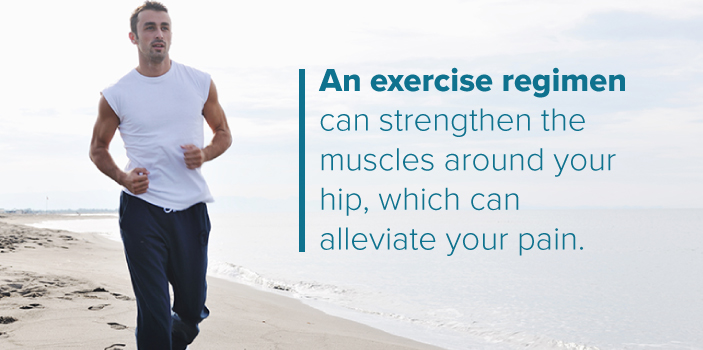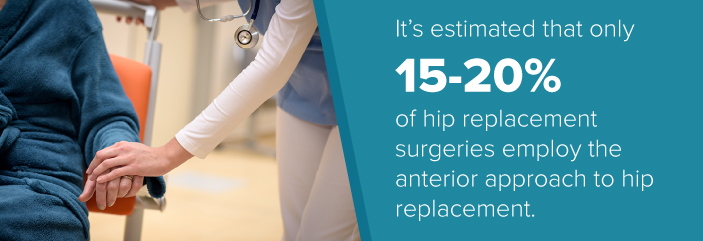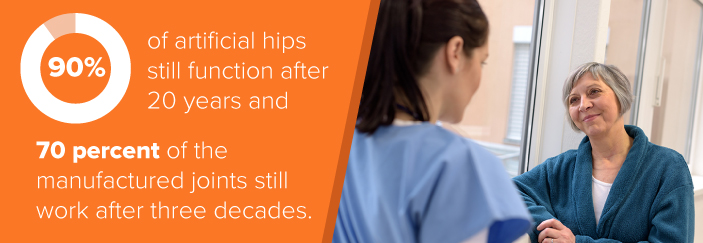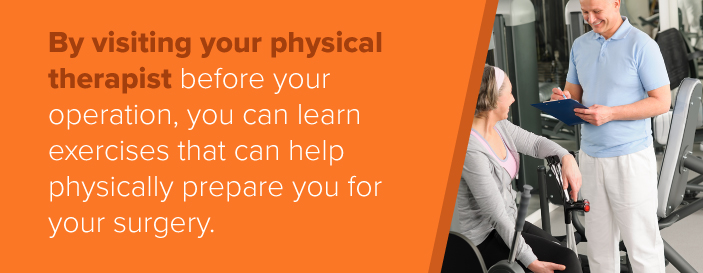– Differences Between Posterior and Anterior Hip Replacement Surgery
– Preparing for Anterior Hip Replacement Surgery
– Recovery After Anterior Hip Replacement Surgery
Conditions That Can Lead to Hip Replacement Surgery
While Roger’s pain started immediately after a near spill on a slippery, sandy beach, his doctor explained that he had an underlying issue that would have made hip replacement surgery inevitable at some point of his life. Common conditions that often lead people to have either posterior or anterior hip replacement surgery include the following:
- Osteoarthritis
- Rheumatoid Arthritis
- Osteonecrosis, also known as Avascular Necrosis
- Injury
- Fracture
- Bone Tumors
For most people, hip pain starts as a minor discomfort and worsens over time as their hip joint continues to deteriorate. Depending on the amount of pain you’re experiencing and how your damaged hip joint is impairing your ability to do routine things, your doctor may initially choose to treat your hip without surgery to delay the procedure for as long as possible. Alternative treatments include the following:
- Exercise: An exercise regimen can strengthen the muscles around your hip, which can alleviate your pain and make it easier for you to perform the tasks that are part of your daily routine.

- Walking Aids: Walking aids such as a cane or walker can relieve some of the stress on your hip, which can help you postpone hip replacement surgery.
- Acetaminophen: If you have hip pain without inflammation, your doctor may use this medicine to control your pain.
- NSAIDs: If you have hip pain with inflammation, your physician may treat your pain with a nonsteroidal anti-inflammatory drug such as aspirin or ibuprofen.
- Topical Treatment: Some people treat their hip pain by applying a topical analgesic product on the skin around their hip.
- Corticosteroid Medications: When NSAIDs fail to reduce a patient’s hip pain, the individual’s doctor may try to delay hip replacement surgery by prescribing corticosteroid medications such as prednisone or cortisone to alleviate the person’s discomfort. Depending on your doctor, they may inject a corticosteroid directly into your hip joint.
Deciding to have hip replacement surgery is a very personal decision. You have to consider various factors, including your finances, health insurance, the length of your recovery, the ability of your friends and family members to help you as you recover and the amount of vacation and sick time you have at work, just to name a few. In general, the time may be right for you to consider hip replacement surgery if you’ve exhausted your alternative treatment options and your pain and loss of joint function have negatively impacted your quality of life.
Differences Between Posterior and Anterior Hip Replacement Surgery

While many people seem to think that total hip replacement using an anterior approach is a new procedure, the truth is that doctors developed the anterior method of hip replacement surgery more than 50 years ago. The Centers for Disease Control and Prevention reports that surgeons perform approximately 332,000 total hip replacements in the United States each year, while the New York Times reported that around 400,000 total and partial hip replacements are performed in America annually.
According to the American Association of Hip and Knee Surgeons, the number of hip replacements performed annually may grow to 500,000 by 2030. Despite the frequency of these surgeries, it’s estimated that only 15-20 percent of hip replacement surgeries employ the anterior approach to hip replacement. However, that doesn’t mean one method is superior to another.
Even though surgeons have performed both posterior and anterior hip replacements for decades, anterior hip replacement surgery has only started to become more common as the medical world strives to provide patients with a more overall positive experience. There are many reasons why more posterior hip replacement procedures are performed, but the two most likely factors are the specialized training and equipment that are typically necessary to conduct anterior hip replacement surgery successfully.
Each approach has unique benefits and risks, which your orthopedic surgeon will discuss with you fully ahead of time. However, in addition to the training and equipment required by those performing the anterior technique, there are some distinct differences.
Both procedures involve removing the damaged head of the femur and any damaged cartilage from the socket. Then, a metal or ceramic ball is attached to the bone, and a new metal socket is put in place. Between the new ball and socket, a plastic spacer allows for a smooth gliding movement. But there are several aspects of these two methods that distinguish each approach to hip replacement surgery from the other:
- Entry Point: In posterior hip replacement surgery, a surgeon will make an incision on the outer buttocks at the back of a patient’s hip or on the side of the person’s hip which is usually ten to twelve inches long. With anterior hip replacement surgery, an incision is made on the front of a person’s hip and is four to five inches long.
- Muscle Detachment: With the posterior approach to hip replacement, a surgeon has to cut through major muscles to access a patient’s hip. Since there are fewer muscles in the front of a person’s hip, a surgeon can work through muscle fibers while performing anterior hip replacement surgery instead of having to cut through them.
- Hospital Stay: With a posterior hip replacement, patients can expect to stay in the hospital for three to ten days. The anterior approach, however, allows them to return home within two to four days.
- Recovery Time: Because the posterior technique involves cutting muscles around the hip joint and giving them enough time to repair, the recovery time is longer — generally two to four months. Since the muscles around the hip joint are not cut with the anterior approach, recovery only takes two to eight weeks.
- Post-Surgical Precautions: When patients undergo a posterior hip replacement, they must follow a set list of very careful precautions for up to 12 weeks to prevent further injury. Because the anterior approach has less risk of complications, there are no specific precautions that need to be followed.
As we mentioned, the posterior method is the approach most commonly utilized by orthopedic surgeons because many believe it gives them better visibility of the joint. They also feel it provides for more precise placement of hip implants. In many ways, the posterior approach is minimally invasive, but the anterior technique is even less invasive.
As the medical world revisits what makes a successful hip replacement, there are those who embrace the anterior approach as a better method of total hip replacement. The actual amount of time spent in surgery is shortened using this technique. It also allows for patients to recover faster, regaining mobility quickly with minimal pain. And many feel that it minimizes the risk of complications for the patient before, during and after the operation.
Even though posterior hip replacement surgery and the anterior approach to hip replacement differ in several key ways, the goal of both procedures is the same. Both surgeries are designed to alleviate anterior hip pain and restore function so that people can resume their normal daily activities without experiencing discomfort, or at least without as much discomfort as they had before surgery.

According to one source, experts consider total hip replacement surgery “among the most valued developments in the history of orthopedics” regardless of which method is used to restore a person’s mobility and reduce the individual’s pain. Hip replacement surgery doesn’t just provide short-term benefits, it also provides lasting ones. According to some studies of knee and hip replacements, 90 percent of artificial hips still function after 20 years and 70 percent of the manufactured joints still work after three decades.
No matter which approach is chosen, the hip joint has one of the highest success rates for recovery after a surgical replacement. The most important factor is not whether to pick posterior or anterior, but the experience and reputation of your surgeon. An experienced doctor will ensure your risk of complications is very low. The team at OIP is well-known in the field of orthopedics both in Pennsylvania and beyond, and we’re here to ensure you have all the info you need to make an informed decision.
Benefits of the Anterior Approach to Hip Replacement
Anterior and the traditional posterior total hip replacements both have excellent outcomes. The real advancement in total hip replacements that has improved patient recovery is the rapid rehabilitation following both types of approaches. Patients are out of bed within 2 hours of surgery and are frequently home within 24 hours of surgery. Exercises learned pre-operatively are started immediately post-operatively, and recovery can be quite rapid. Patients are treated like athletes and not like patients!
However, the anterior approach does seem to have some additional benefits that many patients enjoy when they choose this method of hip replacement. This includes:
- Less Major Muscle Damage: Because the anterior approach avoids cutting through muscle, this allows for less damage to occur as a result of the surgery. It also means surgeons don’t have to make repairs to these muscles once the operation is complete.
- Less Pain: Patients typically don’t experience as much pain because the surgeon doesn’t have to cut through muscle.
- Quicker Recovery: After the surgery is complete, patients are encouraged to move and bear weight as soon as it’s comfortable. This is often not possible with posterior hip replacements.
- Decreased Risk of Hip Dislocation: The muscles and soft tissue around the hip naturally prevent it from dislocating. When these are cut, as with the posterior method, there is a greater risk of hip dislocation. The anterior technique avoids this by not cutting into the muscle.
- Improved Range of Motion Sooner: With the posterior method, patients have to avoid bending at the hip, internal hip rotations and even sitting with their legs crossed for six to eight weeks as this could cause a hip dislocation. However, the anterior method does not place these prohibitions on patients.
Although there are many benefits to having anterior hip replacement surgery, you should be aware of some precautions before you decide to have anterior hip replacement surgery instead of a posterior hip replacement. These include:

- Not for Everyone: Unfortunately, not everyone is a candidate to have an anterior hip replacement even if they need to have a hip replaced. Anterior hip replacement is generally not an option for people who are obese or extremely muscular, for instance, because they have additional soft tissue that can make it hard for a surgeon to access the patient’s hip joint.
- Possible Nerve Damage: One of the anterior hip replacement complications that can arise is possible nerve damage. It’s important to note that nerve damage is also possible if you have a posterior hip replacement. If nerve damage occurs, you may experience numbness in your thigh. While it happens in less than one percent of patients, nerve damage can also cause meralgia paresthetics, which is an irritation of the skin that the damaged nerve supplies.
- Problems With Healing: One of the anterior hip replacement precautions you should know about is that your incision can become irritated if it’s not cared for properly. One study revealed that surgical incision infections occurred in 1.4 percent of patients who’d had anterior hip replacement surgery and 0.2 percent of people who’d undergone posterior hip replacement surgery. This type of mild complication normally resolves itself even if it’s left untreated by a doctor.
Preparing for Anterior Hip Replacement Surgery
“I found a lot of what I did before my surgery was very helpful during my recovery from anterior hip replacement,” said Roger B. “Probably the most important thing I did was get in shape. I’ve always tried to incorporate physical activity into my daily routine, but I made it a point to visit the gym more often than I normally did in the weeks and months leading up to my surgery. I also increased the length of my walks through the neighborhood as much as I could given the pain I was in.”
“I was 72 years old when I had my anterior hip replacement surgery and my kids were grown-ups. My orthopedic surgeon had advised me to arrange for someone to help me since I wouldn’t be able to drive or do certain things around the house for several weeks after my procedure. So, I called one of my daughters who agreed to help me out. Knowing my daughter was going to stay with me took a lot of pressure off when it came to taking care of everything else I needed to get done to prepare for my surgery. It also helped that she arrived in town several days before my operation and was able to help with my last minute preparations.”
While Roger’s daughter was able to help him throughout his recovery, not everyone has friends and family members whose schedules are flexible enough for them to help consistently during a patient’s anterior hip replacement recovery. If you can’t arrange for someone to stay with you, ask your doctor if it’s possible for you to stay in a rehabilitation center while you recover from your surgery.
In addition to making arrangements for your post-operative care and getting in better shape, there are other things you can do to prepare for your anterior hip replacement surgery, including the following:
- Prepare Meals: You can prepare meals that you can freeze before you go into the hospital to minimize the amount of cooking you or your caregiver will need to do in the days immediately following your operation. Potpies, lasagna, baked ziti and certain soups are all freezable options. You can store your food in single serving containers that can be warmed in your microwave with ease, or you can use freezer storage bags to store your meals.

- Rearrange Your Home: Since you’ll probably have to use crutches or a walker after your surgery, it’s critical that you remove any obstacles that may cause you to fall or that will impede your ability to move around your living space prior to your anterior hip replacement. If you have area rugs that may be tripping hazards, remove them. If a decorative table or another piece of furniture constricts a hallway, temporarily relocate the piece to a room that you won’t have to use during your recovery. Borrowing a walker from your doctor’s office and using it to navigate your home before your surgery will help you to identify the things you need to move.
If you have a multi-story home and your bedroom is not on the ground floor, you’ll need to create a sleeping space on the first floor because you will not be able to climb stairs immediately after your surgery. If it’s not practical for you to relocate your current bed because you have a spouse who also needs a place to sleep, consider relocating one from a spare bedroom, buying or renting a hospital bed.
Move the things you’re going to use most often to the place where you’re going to spend most of your recovery time. Make sure your telephone, computer, remote controls and e-reader will be within reach from the seat you’ll be in for the majority of your recovery period. Make sure you have a bell or another device that you can reach easily to alert your caregiver in the event you need emergent or immediate assistance as well.
These steps will help you prepare for your surgery:
- Get the Tools You’ll Need: Depending on the hospital where you’re going to have your surgery performed and your health insurance, staff may provide you with some helpful tools before you’re discharged. These things include items such as reachers, a portable urinal, a raised toilet seat and a shoehorn that has an extra-long handle. Ask your doctor if you’ll be given these things after your anterior hip replacement. If not, ask him or her which items you’re likely to need, inquire about where you can get them and purchase them prior to your procedure.
- Make an Appointment with Your Physical Therapist: By visiting your physical therapist before your operation, you can learn exercises that can help physically prepare you for your surgery. You can also become familiar with the exercises you can do after anterior hip replacement. If you practice these moves beforehand, they’ll be easier for you to do after your surgery.
- Review Your Legal Documents: Certain risks are inherent in any surgical procedure. While anterior hip replacement surgery is not as invasive or life-threatening as many other operations, things can still go wrong. To make sure you’re prepared for any contingency, you should take some time to ensure your affairs are in order prior to having your operation. Review your will and living will. Make sure someone is legally authorized to make decisions on your behalf if you’re unable to do so yourself. Be sure to clearly communicate your wishes to your loved ones and your power of attorney. Doing so will make any decisions they may have to make easier on them.
Anterior Hip Replacement Surgery Recovery

As the less invasive approach to total hip replacement surgery, the anterior technique allows for a shorter recovery and rehabilitation time. This means patients can return to daily activities and even go back to work sooner. However, the recovery process still involves distinct phases to ensure the tissue is healing properly and that you will have maximum functionality.
Although each patient is different, there are a few things you can anticipate during the recovery process after anterior hip replacement surgery. However, your progression depends totally on your unique set of circumstances. One of the greatest advantages about recovering from an anterior approach to hip replacement as opposed to the posterior is that you won’t have to follow any specific anterior hip replacement precautions like not bending past 90 degrees or crossing your leg. This is because there is less risk of dislocation and less leg length discrepancy with the anterior technique.
After undergoing an anterior hip replacement surgery, here are some of the phases of the recovery process you can expect:
- Hospitalization: Patients undergoing the anterior approach usually only stay in the hospital for two to four days. During that time, the patient may receive their initial visit from a physical or occupational therapist. They may even encourage you to stand or walk a few steps using a walker or crutches. Movement after surgery is essential as it increases blood flow and reduces the risk of blood clots.
- Physical Therapy: Formal physical therapy will start shortly after your hospitalization. The goal is to improve muscle strength as well as increase range of motion and mobility. A unique program of exercises will be formulated to meet your specific needs. Therapists will consider any movement restrictions you have as well, so you have the safest possible recovery.

During the antererior hip replacement recovery time, your doctor and your physical therapist will work together to ensure you are on track for a successful recovery. They will be looking out to make sure you reacquire full balance, your tendons and muscles stretch properly and your muscles regain their full strength.
At first, you will have to use a cane or walker to get around. However, unlike the posterior approach, there should be less post-operative pain. In fact, many are able to bend at the waist and put weight on their leg not long after the surgery is complete. This means those who undergo an anterior hip replacement can use a cane or walker sooner. Some patients require the use of pain medication.
After a few weeks of physical therapy, most patients are able to return to functional mobility, moving freely and going about their everyday tasks. A few weeks after that, you should be able to enjoy recreational activities as well. Just remember that everyone is different, and your doctor and physical therapist will be your guide during this process. Some patients take longer to recover fully, and that’s completely okay.
By the time you reach full recovery, there should be little to no pain, especially compared to the discomfort experienced before your surgery. And you should also be able to return to full normal function. There is a risk that the hip will be less flexible than a natural hip. For example, sitting cross-legged on the floor or even simple tasks like putting on your shoes and socks may be more difficult. That’s why it’s important to continue exercising and flexibility training even after physical therapy is complete. Low-impact aerobic exercises, like swimming, biking or walking, will help keep hip muscles strong and flexible.
WHY CHOOSE THE ORTHOPEDIC INSTITUTE OF PENNSYLVANIA

If you have hip pain or you’ve lost some function in one or both of your hips, contact the Orthopedic Institute of Pennsylvania to make an appointment today. We know you have many choices when it comes to orthopedic care, which is why we’re committed to making a difference in your life by going above and beyond your expectations every day. We promise to be part of the solution to whatever health problems you’re currently having and we’ll stand by you and support you as we work through them together.
We’ve improved the lives of other people who lived with pain and the loss of joint function too long, sometimes for years, and we can do the same for you. Don’t just take our word for it, though. Read what some of our patients had to say about their experiences with us:
“I can’t thank you enough for the new life you have given me. I have not been this happy in years.” – OIP Patient
“Dr Lippe was excellent in my care! From the first time I met him, to my surgeries, he was outstanding! Dr Lippe gave me my quality of life back! I will never be able to thank him enough! The pain I was experiencing was ruining my life! But Dr Lippe and his staff were all excellent in my care!” – Patricia C.
“Dr. Frankeny has absolutely given me my life back. It has been six weeks and I am feeling great. I barely use my cane. After enduring pain for over a year and [being] barely able to walk, I cannot believe my good fortune.” – OIP Patient
You don’t have to live with hip pain or be limited by a bad hip any longer. Schedule an appointment with the Orthopedic Institute of Pennsylvania to learn what we can do for you and see why our patients love us so much. We’re excited to be part of your solution.
Stories From Our Patients
Roger B. was a police officer for nearly thirty years before he underwent double knee replacement surgery in the late 1990s. “I knew I needed to have my knees done for years before I actually had the surgery. Even though it was painful to do my normal daily activities, I had to postpone the surgery for as long as I could because my wife had suffered a series of devastating strokes and needed my help on the home front. When I realized I couldn’t tend to her the way I needed to, that’s when I knew I couldn’t put the surgery off anymore.”
“After my wife died several years ago, I resumed fishing and some of the other things I wasn’t able to do during the years leading up to her death. On one fishing trip, I stumbled on the beach and ended up twisting in a way that wasn’t natural. From that point on, I had never-ending pain in my right hip. I tried, in vain, to reduce the pain by changing the way I walked, taking over-the counter pain medication, getting shots in my hip joint, etc., but nothing helped. When I realized I couldn’t pick up my granddaughter anymore because of the pain and I couldn’t sleep for more than an hour or two at a time because of my discomfort, I knew I had to do something.”
“Living in a retirement community, I knew a lot of people who’d had hip replacement surgery due to anterior hip pain. What I didn’t realize, however, was that there were two kinds of total hip replacement surgeries, posterior and anterior hip replacement surgery. The more I learned about the two procedures and the more I thought about what I saw during my neighbors’ differing recovery times and experiences, the more I started to think that the anterior approach was right for me.”
“So, I started to look for an orthopedic surgeon who was familiar with the procedure. I met with several doctors before I found one who was experienced with anterior total hip replacement surgery. Given my doctor’s extended experience with hip replacement and the anterior approach, I decided to go through with the procedure. Moreover, I’ve got to tell you, I’m glad I did. It gave me my life back and it did so a lot faster than I thought it would.”


